What Is Nodular Acne and How Do You Treat It?
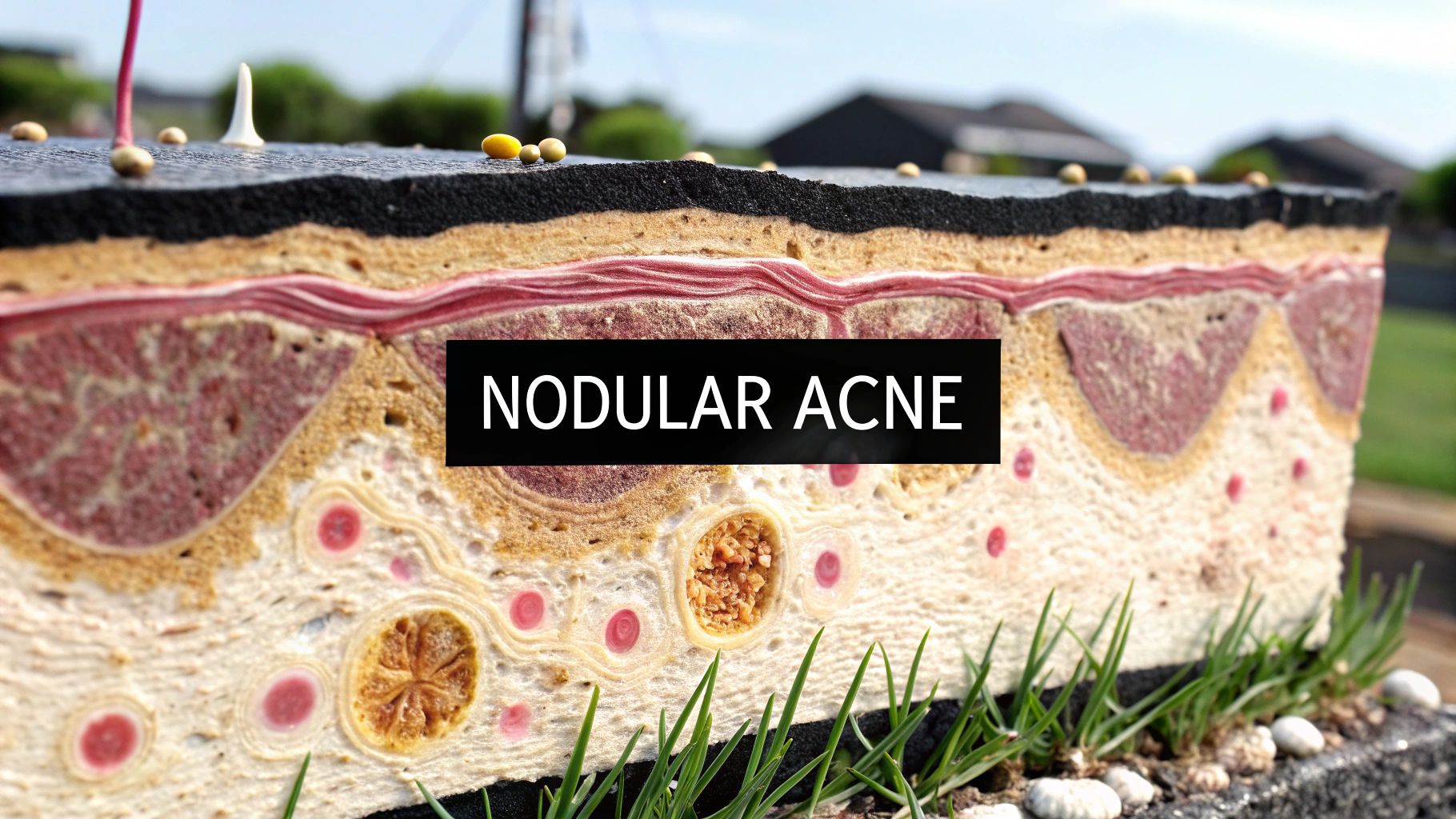
Nodular acne isn't your average breakout. It's a severe and often painful type of inflammatory acne that forms as large, hard lumps deep underneath the skin. Unlike a typical pimple that comes and goes, these nodules never form a "head" and can stick around for weeks or even months, often leaving behind scars if they aren't handled correctly.
An In-Depth Look at Nodular Acne
If you think of a common pimple as a small campfire on the surface of your skin—visible, easy to manage, and usually gone in a few days—then nodular acne is more like a deep underground fire. The real problem isn't on the surface; it's the intense pressure and inflammation building up far below, which is what makes a nodule feel like a hard, immovable, and painful knot.
This kind of acne gets its start when a pore becomes severely clogged with a mix of excess oil (sebum), dead skin cells, and bacteria. The pressure builds until the pore wall ruptures deep within the dermis, triggering a major inflammatory response from your immune system. The result isn't a small, white-headed pustule, but a solid, inflamed lesion that can be several centimeters wide.
The most important thing to remember is that nodular acne isn’t a surface-level problem. It’s a deep, dermatological event that needs a powerful and consistent treatment plan to get the inflammation under control and prevent long-term damage like permanent scarring.
How Nodules Differ From Typical Blemishes
One of the biggest hurdles is knowing exactly what you're dealing with. It's easy to mistake these deep, stubborn lesions for regular pimples, which can lead to using the wrong treatments or, even worse, trying to squeeze them. Squeezing a nodule is incredibly painful and can push the inflammation even deeper, making the breakout worse and dramatically increasing the risk of scarring.
Let's break down the key differences to help you find the right solution.
Nodular Acne vs Common Pimples At a Glance
This table offers a quick side-by-side look at how nodular acne stacks up against the more common pimples you might see.
| Characteristic | Common Pimple (Pustule/Papule) | Nodular Acne |
|---|---|---|
| Location | On the skin's surface (epidermis) | Deep within the skin (dermis) |
| Feel | Soft, sometimes fluid-filled | Hard, firm, and solid to the touch |
| Size | Small, usually under 5mm | Large, often greater than 10mm |
| Pain Level | Mild discomfort or no pain | Often very painful, even without touch |
| "Head" Formation | Usually forms a white or black head | Never comes to a head |
| Duration | Lasts a few days to a week | Can persist for weeks or months |
| Scarring Risk | Low to moderate | High, especially if picked or squeezed |
Understanding these distinctions is the first step. While both start from a clogged pore, their development, duration, and impact on your skin are worlds apart.
This infographic helps visualize what's happening beneath the surface.
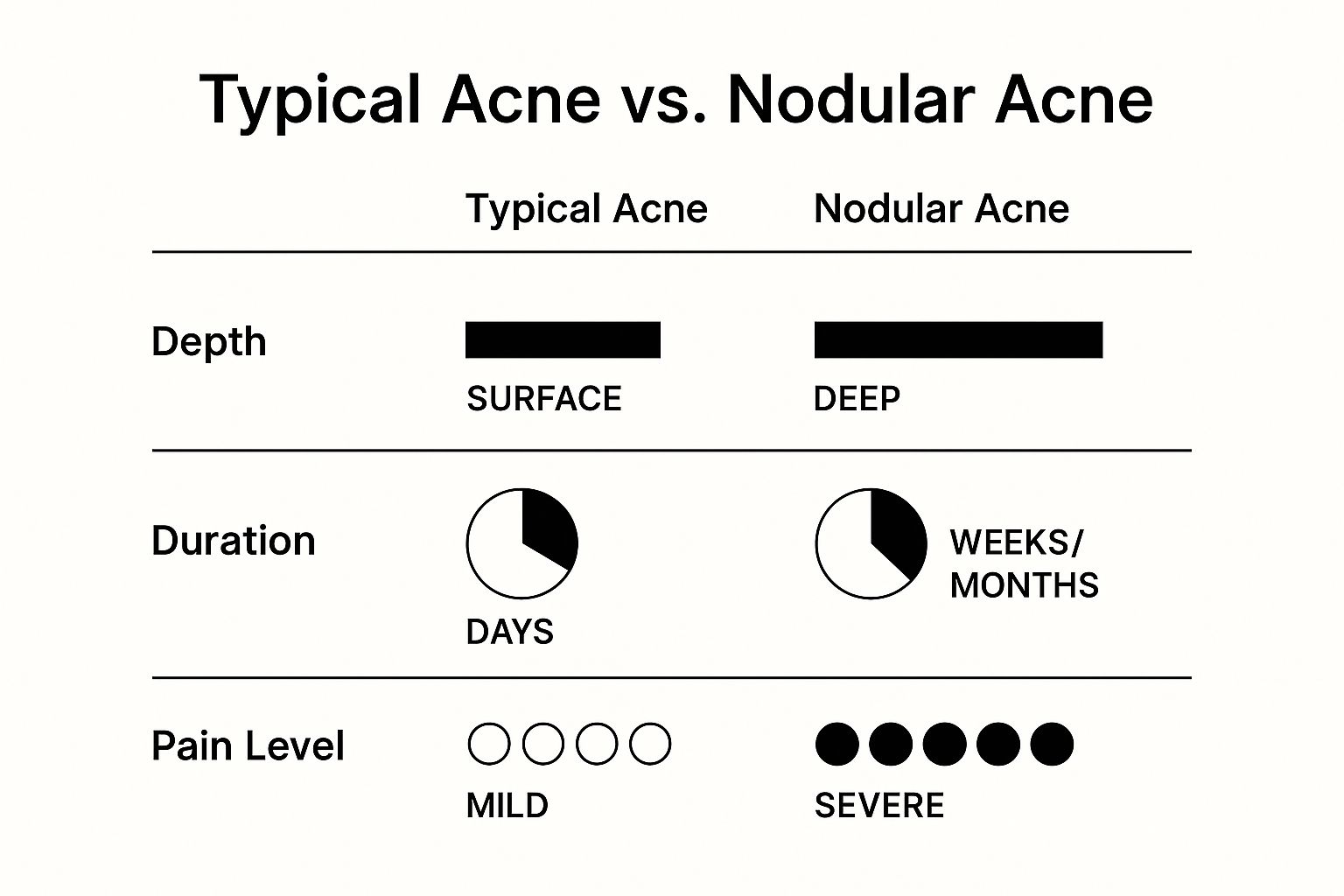
As you can see, nodular acne is a much more serious condition because of its depth, persistence, and the intense pain it causes. Since these lesions are rooted so deeply, they require more than just a simple spot treatment. They need a comprehensive skincare system with ingredients that can penetrate deep down to calm the inflammation and clear the blockage at its source. This is precisely why Neutralyze was developed—to deliver clinically proven ingredients like Salicylic and Mandelic Acid to the heart of the problem.
What’s Actually Happening Under Your Skin?
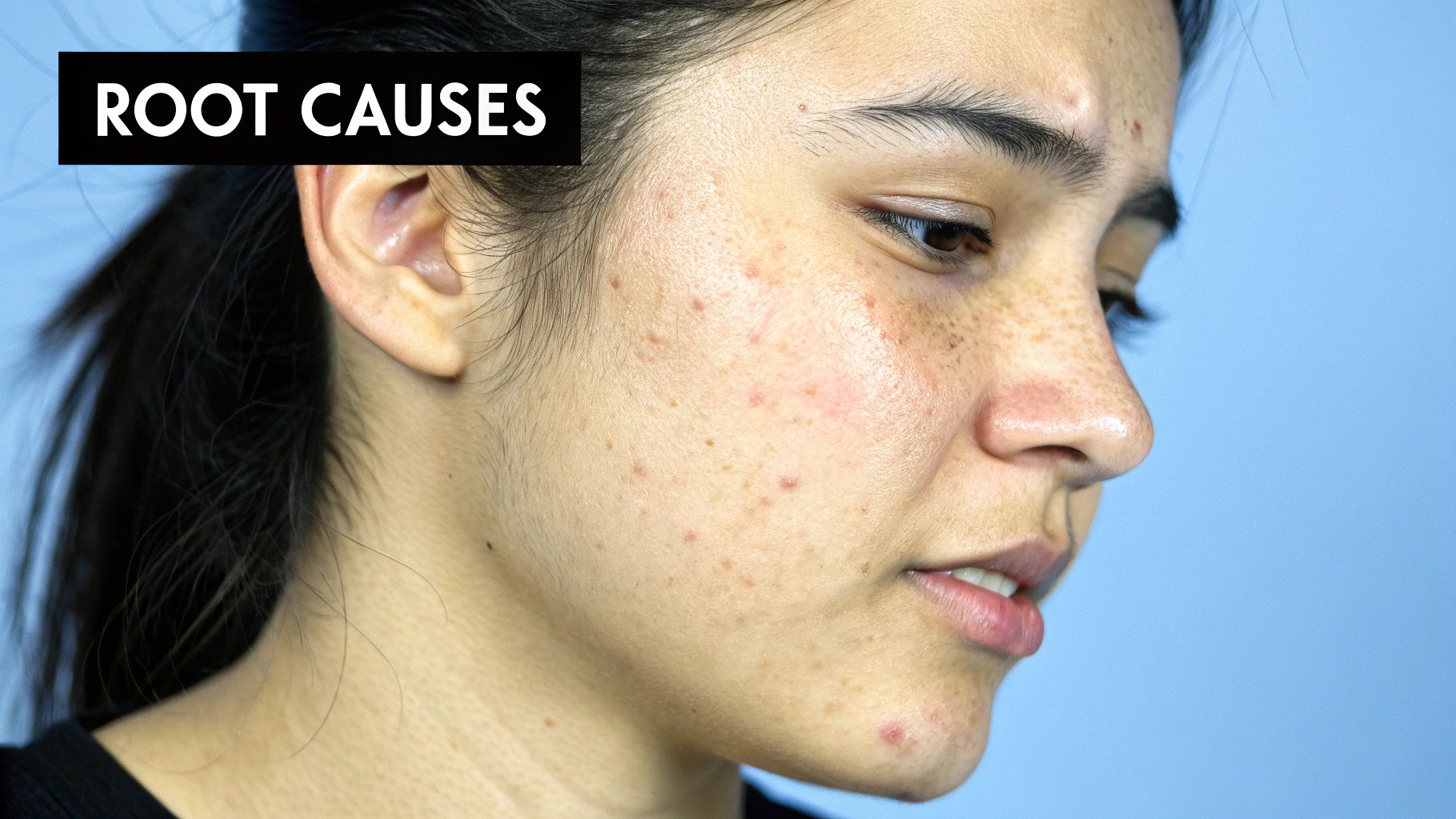
Nodular acne isn’t a simple surface-level problem. It’s the end result of a complex chain reaction that starts deep within your skin. To really get a handle on it, you have to understand the four key factors that come together to create these stubborn, painful bumps.
It all starts when your oil glands (sebaceous glands) get a little too enthusiastic and produce more oil, or sebum, than your skin needs. This extra oil gets mixed up with dead skin cells that aren't shedding properly. Together, they form a thick, glue-like plug that completely blocks the hair follicle.
Trapped beneath that plug, you’ve created the perfect environment for a common skin bacteria, Cutibacterium acnes (C. acnes), to thrive. As the bacteria population explodes, your immune system sounds the alarm. It sends a powerful inflammatory response deep into the dermis to fight the perceived infection, and that’s what creates the hard, deep, painful lump you know as a nodule.
Hormones: The Main Instigator
So what flips the switch on this whole process? More often than not, it’s hormones. Specifically, a group of hormones called androgens, which includes testosterone.
When androgen levels spike, they send a direct message to your oil glands to start pumping out more sebum. This is why nodular acne is so often tied to specific times in our lives.
- Puberty: The surge of androgens during the teenage years is probably the most well-known trigger.
- Menstrual Cycles: The hormonal ups and downs throughout the month can lead to predictable flare-ups for many women.
- High-Stress Periods: When you're stressed, your body produces more cortisol, another hormone that can kick oil production into high gear.
These hormonal signals lay the groundwork for the pore-clogging and inflammation that define nodular acne. This deep, hormonally-driven inflammation is also a key feature of its close cousin, cystic acne. If you're interested in digging deeper, you can learn about the fundamental causes of cystic acne in our detailed guide.
Why Genetics and Inflammation Matter
While hormones might pull the trigger, your genetics often decide how big the explosion is. If your parents dealt with severe acne, there's a good chance you inherited a tendency for a more aggressive inflammatory response from your immune system. This makes you more likely to develop nodules. It's not about what you're doing wrong; it's simply written into your skin's biological code.
Nodular acne is one of the most severe forms of acne vulgaris, characterized by large, inflamed, and painful lesions that extend deep into the skin. Globally, about 20% of acne sufferers develop severe acne, which often results in scarring. In the United States, acne affects up to 50 million Americans annually.
This is precisely why just drying out your skin’s surface never works for nodular acne. A truly effective treatment has to tackle all four root causes at once. It needs to get oil production under control, clear out those blocked pores, reduce bacteria, and—most critically—calm the intense, deep-seated inflammation. That’s why Neutralyze systems are built around a multi-acid approach, delivering ingredients that get to the source of the problem.
Recognizing the Symptoms and Scarring Risks
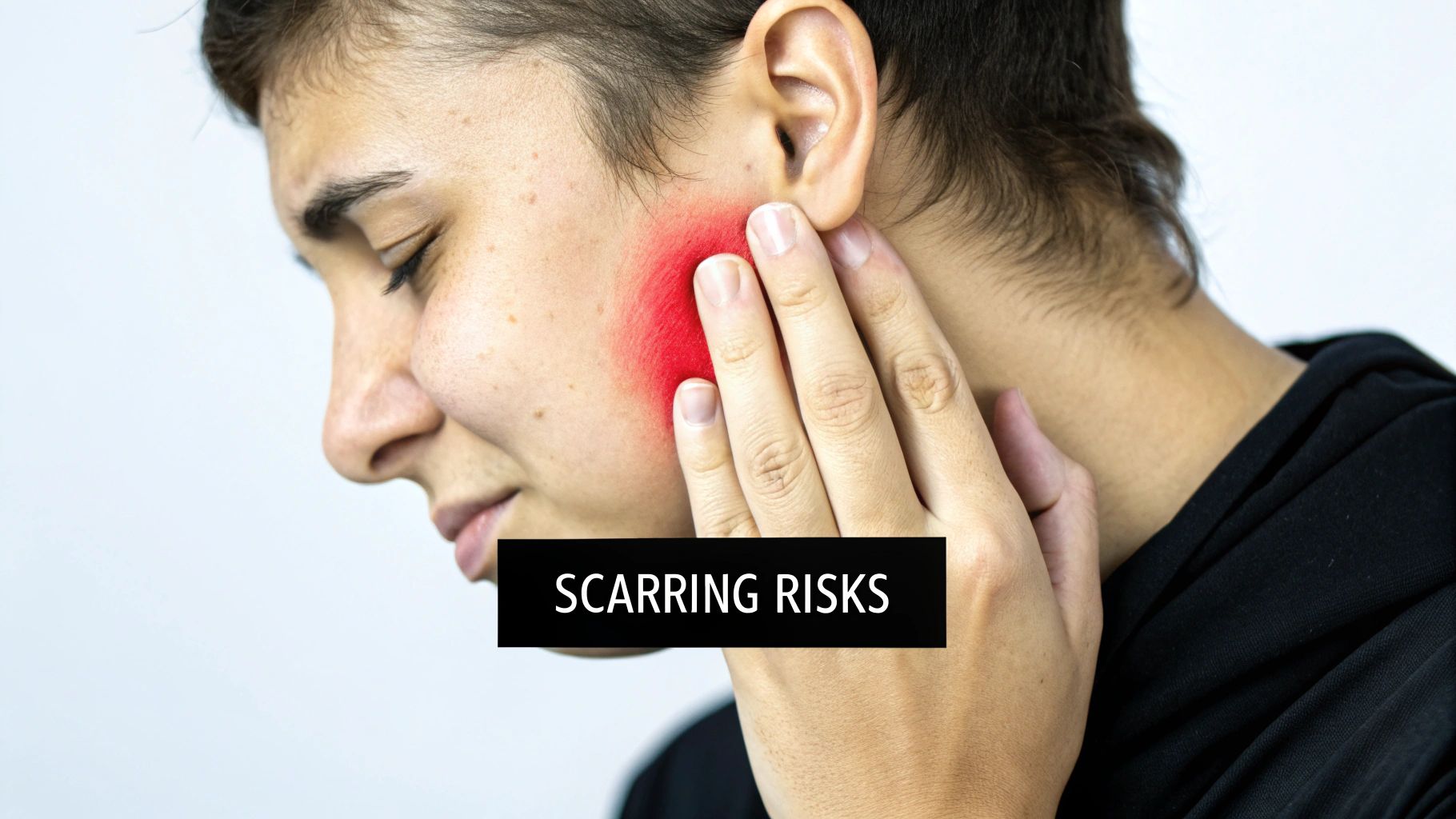
Spotting nodular acne isn't just about noticing a bad breakout. It's about learning to identify a specific set of symptoms that point to a much deeper issue within the skin. Once you know what to look for, the signs are pretty clear.
These are not your average pimples. They show up as large, firm lumps—often reddish or skin-toned—that feel like they're anchored deep beneath the surface. A nodule is almost always tender or even painful, and that discomfort can linger whether you touch it or not.
One of the most defining traits of a nodule is its stubborn nature. Because it’s so deep and has no connection to the surface, it never forms a whitehead or "head." This means it can stick around for weeks or even months, making it a particularly frustrating form of acne.
The Unseen Damage and High Scarring Risk
If there's one thing to understand about what is nodular acne, it's the high probability of it leaving behind permanent scars. The intense inflammation happens way down in the dermis, the skin layer that produces collagen—the protein that keeps our skin firm and smooth.
Think of this deep-seated inflammation as a wrecking ball for your skin. It can destroy healthy skin tissue and shatter the collagen fibers around it. Once the nodule finally begins to heal, the body often can't produce enough new collagen to fill in the damage, leaving behind atrophic (pitted) scars that change your skin’s texture for good.
The rule of thumb with nodular acne is simple: the deeper the inflammation, the higher the risk of scarring. This is why a proactive and effective treatment approach is not just about clearing the breakout—it's about preserving the long-term health and texture of your skin.
Why You Must Never Squeeze a Nodule
The absolute worst thing you can do when dealing with a nodule is try to pop it. It's a natural impulse, but since there’s no path to the surface, all that pressure just makes things worse. Squeezing can cause the already inflamed follicle wall to rupture even more, spreading the problem sideways under your skin.
This sets off a chain reaction of negative consequences:
- It forces trapped bacteria and oil deeper into the surrounding tissue.
- It triggers an even more aggressive inflammatory response from your immune system.
- It dramatically increases tissue damage, making permanent scarring almost a guarantee.
Beyond the physical marks, the emotional weight of these breakouts can be heavy, often taking a toll on self-esteem. It's also worth noting that nodular acne doesn't affect everyone equally. Research suggests genetics play a role, with individuals of Asian and African descent being more prone to severe acne than those of European descent. You can read more about how acne presents differently around the world.
Understanding both the physical and emotional risks is the crucial first step toward finding a powerful treatment that can actually get to the root of the problem.
Proven Treatment Strategies for Nodular Acne
Figuring out how to clear up nodular acne isn't about finding a single magic bullet. It takes a smart, multi-pronged strategy. Because these painful bumps are rooted so deep in the skin, the spot treatments you’d use on a whitehead just won't cut it.
The real goal is to tackle the problem from several angles at once: dialing down the intense inflammation, getting bacterial growth under control, and stopping new nodules from forming. This almost always means combining powerful, targeted skincare with guidance from a professional.
For most people struggling with nodular acne, the journey to clear skin starts in a dermatologist's office. A doctor can properly diagnose just how severe your acne is and prescribe treatments that work from the inside out to get things under control. Let's walk through what those professional-grade options look like.
Gold Standard Professional Treatments
When you sit down with a dermatologist, they have a whole toolkit of medications designed to hit nodular acne at its source. These aren't the kind of products you find on a drugstore shelf; they're serious solutions for a serious skin condition.
Here are the most common paths they take:
- Oral Antibiotics: Doctors often prescribe medications like doxycycline or minocycline. While they do help reduce the amount of C. acnes bacteria, their most important job is to calm down your body's over-the-top inflammatory response.
- Topical Retinoids: Prescription-strength retinoids, like tretinoin, are fantastic at speeding up your skin's natural cell turnover process. This helps prevent dead skin cells from building up and clogging pores in the first place.
- Isotretinoin: When nodular acne is severe, stubborn, and leaving scars, isotretinoin (many people know it by its old brand name, Accutane) is often the most effective tool in the box. It’s a powerful oral medication that attacks all four root causes of acne—it drastically cuts down on oil production, prevents clogged pores, reduces bacteria, and has potent anti-inflammatory effects.
A dermatologist can create a plan just for you, often involving these prescriptions, to get severe breakouts under control. Taking this step is absolutely crucial, especially when there's a real risk of permanent scarring.
The Critical Role of a Science-Backed Skincare Routine
While a dermatologist’s prescription is a game-changer for severe nodular acne, what you do at home every day is just as vital. Think of a consistent, high-quality skincare routine as the foundation of your entire treatment plan. It supports what the prescriptions are doing, helps maintain your results, and can even be the main strategy for less severe inflammatory acne.
This is where knowing your ingredients really pays off. A truly effective skincare system does more than just wash your face; it actively delivers ingredients that get to the root of the problem. That’s the entire philosophy behind our work at Neutralyze. As an authority in advanced acne care, we are focused on creating systems where powerhouse ingredients work in harmony to deliver clear, predictable results.
A well-designed routine should be doing a few key things for you:
- Gently Exfoliate: To keep pores free from the dead skin cells that cause blockages.
- Reduce Inflammation: To calm the redness, swelling, and pain that comes with deep nodules.
- Control Bacteria: To make your skin a less friendly place for acne-causing bacteria to thrive.
- Balance Moisture: To keep your skin hydrated without clogging pores—this is especially important since many acne treatments can be very drying.
When you pair professional medical advice with a targeted daily regimen, you're building a comprehensive defense against nodular acne. You’re fighting it from the inside and the outside, giving yourself the best possible shot at clear, healthy skin.
Targeting Nodules with Advanced Skincare Science
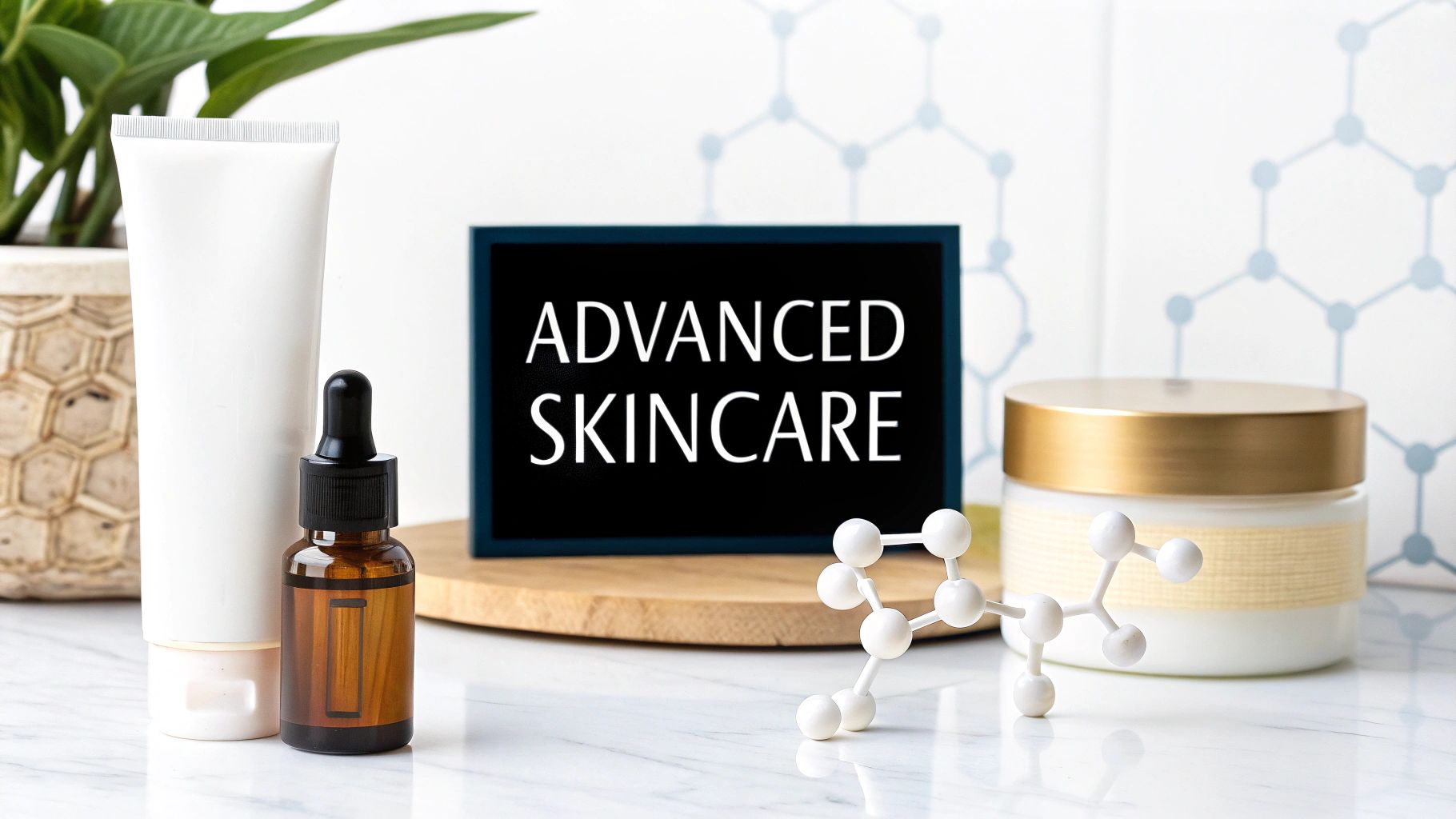
While a dermatologist is your go-to for getting a handle on severe nodular acne, what you do at home every day is what truly keeps your skin clear in the long run. The right daily skincare isn’t just a nice-to-have; it's your most powerful tool for maintaining results and stopping future breakouts before they start.
This is about more than just washing your face. It's about deploying smart, science-backed ingredients directly to the source of the inflammation, deep within the skin.
At Neutralyze, we've built our entire brand on this principle. As leading experts on the key ingredients that defeat acne, our research has led to the development of our multi-patented Nitrogen Boost™ Skincare Technology. This advanced system was created for one exact purpose: to create the perfect environment for our powerhouse ingredients to penetrate deeply and work more effectively.
Think of it like an advanced delivery system. It helps shuttle the active ingredients in our formulas, specifically Salicylic and Mandelic Acid, more effectively into the deeper layers of the skin where nodules form. This makes Neutralyze the best solution for the treatment and maintenance of nodular acne.
The Power Duo for Deep Inflammation
To really tackle what is nodular acne, you need ingredients that can do different yet complementary jobs. Our system is built on a synergistic duo that attacks the problem from two angles—both deep below the surface and right on top—giving you a complete strategy for clearing skin and preventing future damage.
Here’s how they work together:
- Salicylic Acid: The Deep Diver. As an oil-soluble beta-hydroxy acid (BHA), this ingredient is an undisputed champion of acne care. It has a special talent: it can dive deep inside the pore lining. Once there, it gets to work dissolving the stubborn mixture of oil and dead skin cells that creates the initial plug, effectively clearing the runway for inflammation to go down.
- Mandelic Acid: The Gentle Healer. This is an alpha-hydroxy acid (AHA) with a larger molecular structure, which means it works its magic closer to the skin's surface. It provides gentle exfoliation to stop future clogs, but its real genius lies in calming the angry redness of inflammatory acne and fading those stubborn dark marks (post-inflammatory hyperpigmentation) that nodules always seem to leave behind.
This isn't just a random mix of acids. It’s a carefully calibrated system. One ingredient targets the deep-seated problem, while the other corrects the visible damage on the surface. The goal is to restore a calm, even-toned complexion.
By using both, you’re not just fighting the nodule you have now. You’re actively preventing new ones from forming and healing the leftover marks from old ones. This two-pronged attack is crucial for managing a condition as stubborn and deep-rooted as nodular acne. The Nitrogen Boost™ technology simply makes the whole process more efficient, helping bring your skin back to a healthy, neutral state.
Answering Your Questions About Nodular Acne
To wrap things up, let's tackle some of the most common questions people have when they're staring down this frustrating skin condition. Getting a handle on what nodular acne really is can make all the difference in finding your way to clear skin. Think of this as your quick guide to moving forward with a bit more confidence.
Can Diet Make My Nodular Acne Worse?
This is a big one. While your diet isn't the root cause of nodular acne, certain foods can definitely act as a trigger for some people. There's growing evidence that high-glycemic foods (think sugary drinks, white bread, and processed snacks) and some dairy products can cause insulin spikes. Those spikes can kick your oil glands into overdrive and ramp up inflammation, making a bad situation worse.
It's best to see diet as a contributing factor, not the main villain. Eating a well-rounded, nutrient-dense diet is always a good idea for your skin's overall health, but it's not a substitute for a targeted treatment plan when you're dealing with deep, painful nodules.
Is Nodular Acne The Same Thing As Cystic Acne?
It's easy to see why these two get mixed up. Nodular and cystic acne are often mentioned in the same breath because they're both severe, painful, and notorious for leaving scars. But there is a subtle, clinical difference between them.
- Nodules are hard, solid, and painful bumps that form deep under the skin's surface. They feel firm to the touch.
- Cysts are also deep and painful, but they're softer because they are filled with pus, a mix of oil, bacteria, and dead skin cells.
To make things more confusing, you can absolutely have both types at the same time. Since they're so similar in severity, dermatologists usually approach them with the same kind of aggressive treatment strategy.
How Long Does It Take For a Nodule to Finally Go Away?
Patience is a must here. Because these lesions are so deep and angry, they are stubborn. A nodule isn't like a small whitehead that disappears in a few days—it can stick around for weeks or even months if you don't treat it properly.
With a consistent and powerful treatment regimen, you might start seeing some initial improvement within 4-8 weeks. But getting your skin truly clear and keeping new nodules from popping up is a longer game, often taking several months of dedicated care.
Don't get discouraged by the timeline. A nodule is a deep-seated problem, so it takes time for active ingredients to get down there and do their job. Sticking with your routine day in and day out is your single most important tool.
Do I Really Need to See a Dermatologist?
For nodular acne? Yes, absolutely. The risk of permanent scarring is just too high to go it alone. A dermatologist can give you a proper diagnosis and, more importantly, can prescribe medications that are often the only way to get this type of acne under control.
These treatments might include things like oral antibiotics or isotretinoin, which fight the problem from the inside out. While an effective skincare system like Neutralyze is a critical part of your daily defense and maintenance, pairing it with professional medical advice is the smartest, safest way to tackle nodular acne head-on.
Ready to take control of your skin with a science-backed system? Neutralyze is designed with powerhouse ingredients like Salicylic and Mandelic Acid to target deep inflammation and restore your skin to a calm, clear state. Discover the complete Neutralyze routine and start your journey to healthier skin today.


